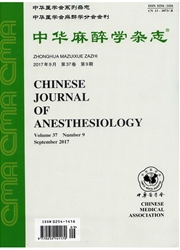

 中文摘要:
中文摘要:
目的 探讨不同吸入麻醉药对人精子运动功能和体外获能的影响.方法 成年男性精液经Percoll梯度离心法处理后,沉淀精子置于人精子体外获能培养基,调节精子密度(30~50)×106/ml,随机分为5组(n=7):对照组(C组)正常培养,2%、4%七氟醚组(SEV1、2组)和1.1%、2.2%异氟醚组(ISO1、2组)在37℃孵箱中分别暴露于2%、4%七氟醚和1.1%、2.2%异氟醚5 h,采用计算机辅助精子分析系统评价精子运动功能,记录精子运动活力[(a+b)%]、曲线速度(VCL)、直线速度(VSL)、平均速度(VAP)和头部侧向运动平均振幅(ALH),采用金霉素荧光染色技术评价精子体外获能情况.计算吸入麻醉药组各指标的相对抑制率.结果 与C组比较,SEV1组、SEV2组和ISO2组(a+b)%、VCL、VSL、VAP降低,SEV2组ALH、SEV2组和ISO1、2组精子获能程度降低(P<0.05);与SEV1组比较,SEV2组(a+b)%、VCL、VSL、VAP降低,ISO1组(a+b)%、VCL、VSL、VAP的相对抑制率降低(P<0.05);与ISO1组比较,ISO2组(a+b)%、VCL、VSL、VAP降低(P<0.05);与SEV2组比较,ISO2组(a+b)%、VCL、VSL、VAP和ALH的相对抑制率降低(P<0.05).结论 七氟醚和异氟醚均可呈剂量依赖性地抑制人精子运动功能和体外获能;七氟醚抑制精子运动功能的作用较异氟醚强.
 英文摘要:
英文摘要:
Objective To investigate the effects of inhalation anesthetics on human sperm motility and capacitation in vitro. Methods Sperm samples were obtained from normal adults and prepared with discontinuous percoll gradient centrifugation technique. The samples were incubated for 5 h in an airtight glass container filledwith 5% CO2-95% air at 37 ℃ with or without sevoflurane (SEV 2%, 4% ) or isoflurane (ISO 1.1%, 2.2% ).Then human sperm motility was examined in vitro at 37℃ and analyzed by the computer-assisted sperm analysis (CASA), including sperm motility (a + b)%, curvilinear velocity (VCL), straight line velocity (VSL), averagepath velocity (VAP) and amplitude of lateral head displacement (ALH). The capacitation effect was assessed by using the chlortetracycline (CTC) staining and phase-contract microscopy. Results 2% and 4% SEV significantly reduced (a + b)% , VCL, VSL and VAP in a dose-dependent manner, while only 4% SEV significantly decreased ALH and the capacitation ability of the sperm compared with control group. 2.2% ISO significantly decreased ( a + b)%, VCL, VSL and VAP compared with control and 1.1% ISO group. The capacitation ability of the sperm was significantly decreased by 1.1% and 2.2% ISO as compared with control group. Conclusion Sevoflurane and isoflurane have significant inhibitory effects on human sperm motility and capacitation in a dose-dependent manner. Sevoflurane has stronger inhibitory effect than isoflurane.
 同期刊论文项目
同期刊论文项目
 同项目期刊论文
同项目期刊论文
 期刊信息
期刊信息
